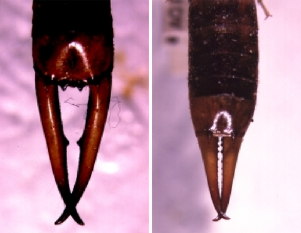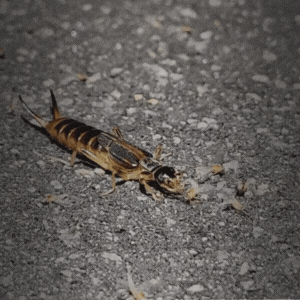
As our community continues to recover from recent storms, find helpful resources and information at tiny.cc/ufsaraext_disasterprep, tiny.cc/saraco_disasterprep, and scgov.net/government/emergency-services/storm.
This blog is part of a multi-part series. To meet other members of “The Spooky Bug Brigade,” visit our blog’s landing page.
Earwigs (Dermaptera)

Credit: Lyle Buss, UF/IFAS
Description

Credit: P.M. Choate, UF/IFAS
Have you ever heard the age-old myth that earwigs get their name by burrowing into your ear at night? Well, one part of that is true. They are nocturnal, coming out at night to look for food. The rest of it, however, is far from the truth. They may look a bit creepy with large, pincer-like cerci jutting out from their abdomens, but they’re nothing to fear. These cerci, curved in males and straight in females, are used for mating, fighting, and capturing prey. Talk about versatile! They rarely pinch people, and if they do, it typically won’t break the skin. You are very unlikely to receive a pinch unless severely mishandling one. That said, you may be subject to a foul-smelling spray if you happen to pick one up.
Often ranging from brown to black in color, earwigs have long, flattened bodies that are typically a half inch to an inch in length. Their wings, when present, are short and do not extend far past the thorax, or mid-section of the insect. Their antennae are threadlike and have at least 10 segments.
There are six families of earwigs in Florida, with some of the most frequently encountered species being the ringlegged earwig (Euborellia annulipes), striped earwig (Labidura riparia), and lined earwig (Doru taeniatum). The European earwig (Forficula auricularia), pictured above, is commonly found in other parts of the country but is unlikely to establish in Florida due to its climatic preferences.
Services

Credit: © Isaac Lord, some rights reserved
Earwigs can be scavengers, predatory, or omnivorous, often eating small insects and plant material. This wide variety of dietary preferences allows earwigs to serve us in a couple different ways. First, earwigs that scavenge help break down organic matter and return nutrients to the soil. Predatory and omnivorous earwigs provide free pest control by munching on common garden pests, such as aphids, scales, mites, small caterpillars, leafhoppers, and beetle larvae.
That said, earwigs that feed on living plant tissue are not very popular and can occasionally be considered pests themselves in both gardening and agriculture. However, the damage is usually minimal and often outweighed by their benefits, rarely warranting treatment. Not to mention, they also serve as food for wildlife, including toads and birds.
Habitat
Outside, earwigs tend to hide under mulch, soil, thatch, or debris during the day. This is so they can stay protected while they rest. At night, they come out to scavenge, forage, and hunt. Predatory earwigs look for prey around light sources, which are often attractive to insects. They may come into the home on occasion if conditions are favorable. Eliminate hiding places by sealing any cracks and crevices in your walls or foundation. Also be sure to remove any possible food sources, such as dead bugs or plant material, checking potted plants for hitchhikers (and relocating them outside). Additionally, reduce moisture by fixing leaks and using a dehumidifier as needed.
 If you find a large number of earwigs indoors, chances are they are well-established in the surrounding outdoor area. In this case, create some space between any organic material, such as mulch, soil, or compost, and your structure’s foundation.
If you find a large number of earwigs indoors, chances are they are well-established in the surrounding outdoor area. In this case, create some space between any organic material, such as mulch, soil, or compost, and your structure’s foundation.
Trapping earwigs can often provide sufficient control, suppressing populations to an acceptable level. One way to trap them is to roll up a newspaper, slightly wet it, and place it in the garden during the evening. The following morning, check the newspaper for earwigs and dispose of it accordingly.
You can also try filling a plant pot with wood shavings, then placing it upside down. Place a stake through the drainage hole to help secure it. Earwigs may be tempted to shelter in the shavings after a long night of looking for food. Regularly use traps until the problem has been resolved.
In the majority of cases, control of earwigs is unnecessary and can often do more harm than good.
Fun Fact
Earwigs have been shown to provide maternal care. An earwig mother will protect, clean, and tend to her eggs once laid. She’ll even stick around to feed her nymphs during their first stage of development. Not only that, but she can sense pathogens in the environment and increase her level of care in response. How sweet! Less sweet, however, is that newly hatched nymphs will try to eat their younger siblings. To make matters worse, after they’ve grown old enough, their mothers will lose their maternal instinct and try to eat them too. It’s all a balance, I guess.
Learn more about these misunderstood guardians of the garden by clicking here.
Resources
- UF/IFAS Featured Creatures: https://entnemdept.ufl.edu/creatures/
- UF/IFAS Insect ID Lab: https://entnemdept.ufl.edu/insectid/
- IPM Florida: https://ipm.ifas.ufl.edu/
- UF/IFAS Extension Sarasota County, Chemicals in the Environment: https://sfyl.ifas.ufl.edu/sarasota/natural-resources/chemicals-in-the-environment/
Credits
- Featured image: Cristina Carrizosa, UF/IFAS
- Photos: Credited in caption
- Graphics: Designed in Canva
 5
5
